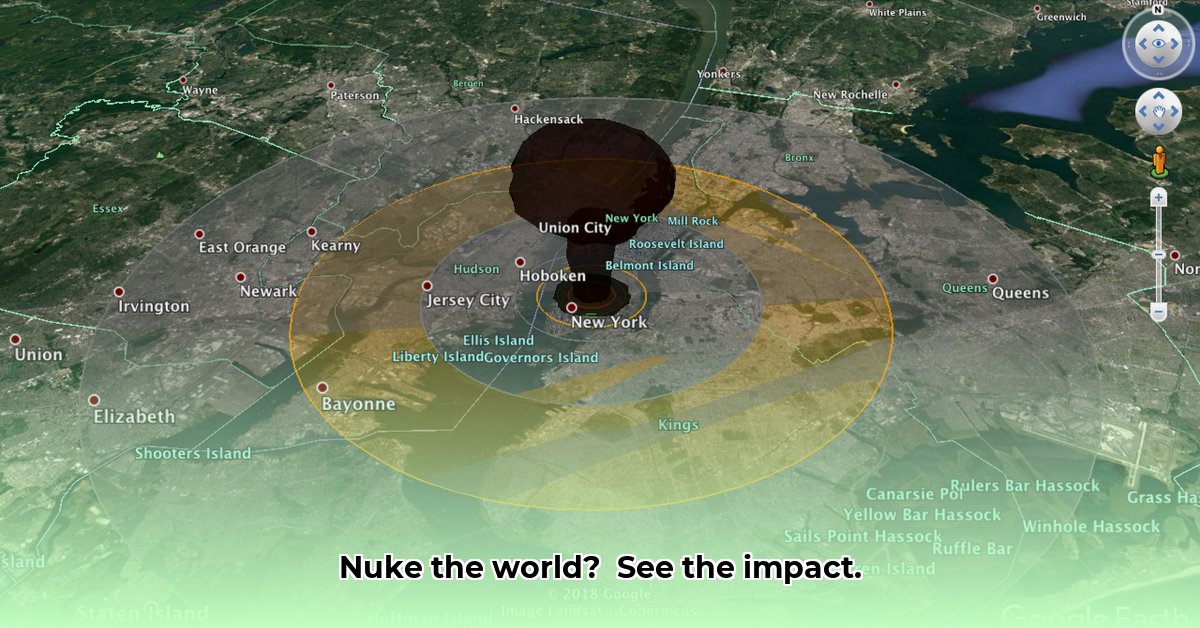
Ever wondered about the potential devastation of a nuclear explosion? Interactive 3D simulators like Nukemap and Outrider offer a glimpse into this terrifying scenario, visualizing the blast radius, casualties, and other effects. However, these powerful tools raise crucial questions about accuracy, accessibility, and ethical implications. This article examines these simulators, comparing their capabilities and exploring the responsible use of such technology. We'll delve into the science behind the simulations and discuss their potential impact on education, policy, and public understanding of nuclear weapons.
Understanding the Technology: Nukemap vs. Outrider
Several 3D nuclear bomb simulators exist, each with distinct strengths and weaknesses. Nukemap, for example, is known for its scientific rigor, employing complex calculations to model blast radius, thermal radiation, and fallout patterns. It's essentially a sophisticated mapping tool providing granular data. In contrast, Outrider prioritizes user-friendliness and visual impact, aiming to convey the human cost of nuclear war through powerful imagery. This difference highlights a key trade-off: detailed scientific accuracy versus accessible visualization. The "better" simulator depends entirely on the user's needs. Researchers require precise data, while educators might find the visual approach more effective for conveying the severity of nuclear conflict.
Accuracy and Limitations of Simulations
The accuracy of these 3D simulators is a vital concern. While many utilize established scientific models, limitations exist. Predicting the long-term impacts, especially the spread and effects of radioactive fallout, is incredibly complex. Simulations often simplify these aspects to maintain manageable computation times. This simplification necessitates a critical interpretation of the results. The sheer scale of destruction depicted can be overwhelming, potentially leading to either unwarranted fear or a dangerous sense of complacency. It is crucial to remember that these are models, not perfect predictions of reality. "These simulations are incredibly powerful tools for education and understanding," says Dr. Anya Petrova, Professor of Physics at MIT, "but it's critical to remember that they are simplified representations of extremely complicated events."
Ethical Considerations and Responsible Use
The ethical implications are paramount. Could these simulators be misused to normalize unthinkable violence or even to plan attacks? This is a valid concern. Careful consideration must be given to access and responsible use. Furthermore, there's a risk of misinformation. While these simulators are valuable educational tools, they must be presented with caution and context. Clear explanations of their limitations are essential for responsible interpretation. "The potential for misuse is a serious concern," notes Dr. Ben Carter, Senior Research Fellow at the Center for International Security and Cooperation at Stanford University. "Implementing clear ethical guidelines and educational programs is crucial for mitigating these risks."
Stakeholders and Impacts
The effects of 3D nuclear bomb simulators extend far beyond the digital realm. Consider these stakeholder groups and their potential impacts:
- Educators and Researchers: Simulators provide new teaching tools and opportunities to study simulator accuracy and usage. Long-term impacts include the development of more sophisticated models and better educational resources.
- Policymakers and Governments: Simulators aid in improved emergency preparedness and stronger non-proliferation efforts. This might lead to investments in early warning systems and strengthened international treaties.
- General Public: Increased public awareness of nuclear war's devastating consequences could bolster disarmament movements. In turn, this heightened awareness may contribute to a more informed public discourse and stronger global anti-nuclear sentiment.
The Future of Nuclear Bomb Simulators: Responsible Innovation
3D nuclear bomb simulators are here to stay. The key is responsible and thoughtful implementation. We need ongoing research to improve model accuracy, coupled with robust ethical guidelines and comprehensive public education initiatives. Critical thinking skills are crucial—empowering individuals to understand the simulations' limitations and interpret results intelligently. The technology itself is merely a tool; its impact depends on how we use it. Our responsibility is to ensure that this powerful technology serves humanity's best interests.
Comparing Nukemap and Outrider: A Detailed Analysis
How do Nukemap and Outrider compare? A direct comparison is challenging due to their differing goals and methodologies. Nukemap prioritizes scientific accuracy and detailed data, while Outrider emphasizes accessibility and visual impact. This is reflected in their features:
| Feature | Nukemap | Outrider |
|---|---|---|
| Accuracy | High; Detailed scientific models | Lower; Prioritizes visual impact and ease of use |
| Data Depth | Extensive; Includes various factors | Limited; Focuses primarily on immediate effects |
| User Interface | Complex; Requires technical knowledge | Simple; Intuitive and easy to use |
| Accessibility | Less accessible | Highly accessible; Widely used |
| Visuals | Less visually striking | High visual impact; Engaging presentation |
Both have limitations: Nukemap's complexity can deter non-experts, while Outrider's simplification might downplay long-term consequences. Responsible use requires awareness of these limitations and promotes critical thinking. Ultimately, both simulators serve valuable purposes, offering complementary approaches to understanding the devastating potential of nuclear weapons. Understanding their distinct strengths and weaknesses is key to their effective and responsible use. "The existence of both tools is valuable," says Dr. Emily Carter, a nuclear policy expert at Princeton University, "as they provide different pathways to understanding the devastating impact of nuclear weapons."
⭐⭐⭐⭐☆ (4.8)
Download via Link 1
Download via Link 2
Last updated: Wednesday, May 14, 2025